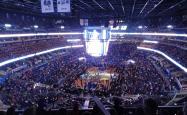篮球场设计图室内图片
Title: Designing an Ideal Basketball Court: Key Considerations and Layout
Creating a welldesigned basketball court involves more than just marking boundaries and putting up hoops. It requires careful planning to ensure functionality, safety, and player enjoyment. Let's delve into the essential elements and considerations for designing an ideal basketball court layout.
1. Dimensions and Markings:
Court Size:
The standard dimensions for a basketball court are 94 feet in length and 50 feet in width for professional games, while recreational courts can vary but often measure around 84 feet by 50 feet.
Markings:
Markings include the center circle, freethrow line, threepoint line, key or paint area, and boundary lines. These markings must adhere to official regulations to maintain consistency and fairness during gameplay. 2. Surface Material:
Hard Court:
Asphalt or concrete surfaces are common choices due to their durability and low maintenance requirements.
Indoor Court:
Wood or synthetic materials like hardwood or rubber are preferred for indoor courts, providing better shock absorption and traction. 3. Hoops and Backboards:
Height:
Regulation hoop height is 10 feet from the ground to the rim, both for professional and recreational play.
Backboard:
Choose durable materials like tempered glass or acrylic for backboards to withstand repeated impact from basketballs. 4. Court Orientation:
Direction:
Ideally, position the court north to south to minimize the impact of sunlight during gameplay.
Surroundings:
Consider surrounding structures or landscape features that may affect wind patterns or lighting conditions. 5. Safety Features:

Padding:
Install padding around the base of the hoops and along the walls to prevent injuries from collisions.
NonSlip Surface:
Ensure the court surface provides sufficient grip to prevent slips and falls, especially in wet conditions. 6. Accessibility:
ADA Compliance:
Design the court with accessibility in mind, including ramps or designated areas for wheelchair users.
Space:
Allow ample space around the court for spectators, benches, and other amenities without obstructing pathways. 7. Lighting:
Uniform Illumination:
Install lighting fixtures evenly distributed across the court to minimize shadows and ensure consistent visibility.
Brightness:
Aim for sufficient brightness levels to facilitate gameplay during evening or indoor sessions. 8. Aesthetics:
Color Scheme:
Choose colors for court markings and surfaces that enhance visibility and complement the surrounding environment.
Branding:
Incorporate team or sponsor logos tastefully onto the court surface without interfering with gameplay. 9. Maintenance Considerations:
Cleaning:
Establish a regular cleaning schedule to remove debris and maintain the court's appearance and functionality.
Repairs:
Promptly address any damages or wear to the court surface, hoops, or markings to ensure safety and longevity. 10. Regulatory Compliance:
Local Regulations:
Familiarize yourself with local zoning laws, building codes, and regulations governing the construction and use of sports facilities.
League Standards:
Adhere to the standards set by relevant sports organizations or leagues to ensure the court is suitable for official competitions if desired.In conclusion, designing an ideal basketball court involves careful attention to detail across various aspects, including dimensions, surface materials, safety features, and aesthetics. By considering these key factors and consulting with experts as needed, you can create a functional and enjoyable space for basketball enthusiasts of all ages and skill levels to play and compete.









